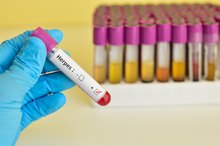Bumps in the Corners of the Lips
**Some lumps and bumps are easy to hide under clothing -- but not so when you develop an unsightly bump on your lip.
** A bump at the corner of your lips is most often due to something simple, such as a cold sore or chapped lips. But there are other possibilities, too, including skin cancer. The appearance of the bump along with how quickly it developed and accompanying symptoms help point to the most likely cause.
Cold Sores
Cold sores are most often caused by the herpes simplex 1 virus (HSV1). They can occur anywhere on the lips, including the corners, and tend to recur in the same place.
Initial infection typically occurs before age 20 and is very common, as HSV1 is highly contagious. Roughly one-third of people who have been infected have recurrent cold sores, according to a December 2008 "Canadian Family Physician" article 3.
About 60 percent of people note burning, tingling or itchiness at the site before a painful cold sore develops. It appears as a cluster of tiny, fluid-filled bumps.
An untreated cold sore typically heals in 7 to 10 days. Prompt treatment with an oral or topical antiviral, such as famciclovir (Famvir) or valacyclovir (Valtrex), can reduce the duration and symptoms of a cold sore. Over-the-counter cold sore treatments may also relieve symptoms.
- Cold sores are most often caused by the herpes simplex 1 virus (HSV1).
- About 60 percent of people note burning, tingling or itchiness at the site before a painful cold sore develops.
Angular Cheilitis
Bumps on the Edge of the Lips
Learn More
Angular cheilitis (AC) is the unwieldy medical term for inflammation at one or both corners of the mouth. AC is relatively common, and almost everyone who has it also has chapped lips. These painful sores typically begin as small cracks at the corners of the lips, which then become inflamed and red. The area often cycles through bleeding and crusting over.
**Open AC sores often become infected with bacteria or yeast, which further aggravates the condition.
** Uninfected AC sores often go away with simple topical treatments, such as petroleum jelly. Antifungal or antibiotic creams are recommended for infected AC.
Hydrocortisone cream might also be used to reduce inflammation. AC can occur due to a variety of causes, including: -- anemia -- riboflavin deficiency -- poorly fitting dentures -- braces or other orthodontic appliances -- reaction to lipstick, balm or oral hygiene products -- habitually licking the lips -- mouth breathing or drooling
- Angular cheilitis (AC) is the unwieldy medical term for inflammation at one or both corners of the mouth.
- Open AC sores often become infected with bacteria or yeast, which further aggravates the condition.
Common Warts
While not limited to the corners of the lips, warts often occur in this area. Common warts are caused by certain subtypes of the human papillomavirus (HPV). Warts are well-defined, firm growths that have a rough surface and are usually painless. Although they usually go away on their own, a common wart may not disappear for 2 or more years. Therefore, most people opt for treatment or removal to get rid of these unsightly growths near the lips.
- While not limited to the corners of the lips, warts often occur in this area.
- Therefore, most people opt for treatment or removal to get rid of these unsightly growths near the lips.
Pimples and Fordyce Spots
Earlobe Wart
Learn More
The corners of the mouth are a frequent site for pimples. The usual treatments used elsewhere on the face can be used, although care must be taken to not get topical treatments into the mouth.
Large Fordyce spots are sometimes confused with pimples and can also occur at the angle of the lips. Like other areas of the skin, the lips have sebaceous glands that secrete oils to lubricate and moisturize. Fordyce spots are white to yellow spots at the opening of the sebaceous glands on the lips and genitals.
They are usually very small, but can sometimes become large, causing a bump anywhere along the edge of the lip. These painless bumps are harmless and require no treatment.
- The corners of the mouth are a frequent site for pimples.
- Large Fordyce spots are sometimes confused with pimples and can also occur at the angle of the lips.
Lip Tumors
An unexplained bump at the corner of your lips might represent a tumor, especially among seniors.
These tumors can be noncancerous or cancerous, so there's no need to panic. One possibility is a pyogenic granuloma, a noncancerous tumor consisting of a mass of blood vessels that tend to bleed easily. They occur most commonly in children, but affect women more often than men among adults. These growths typically arise painlessly and rapidly over a few weeks, and can be easily removed.
Skin cancer is a not-to-be-missed cause of a bump along the angle of the lips. The face is one of the most exposed areas to ultraviolet radiation from the sun.
**Skin cancer is most common among older adults, who have accumulated many years of sun exposure.
** Smoking and alcohol abuse increase the risk of skin cancers of the lip. These tumors are usually painless, but might be itchy. The most common types of skin cancer -- basal and squamous cell carcinoma -- are usually curable, if diagnosed and treated early.
- An unexplained bump at the corner of your lips might represent a tumor, especially among seniors.
- These tumors can be noncancerous or cancerous, so there's no need to panic.
Cautionary Notes
The most common causes of bumps in the corners of the lips do not represent a significant threat to your health. But it's important not to ignore these growths, especially if they persist or are not from an obvious cause. See your doctor if you have bumps at the corners of your lips to determine the cause and appropriate treatment.
Reviewed by: Tina M. St. John, M.D.
- The most common causes of bumps in the corners of the lips do not represent a significant threat to your health.
Related Articles
References
- Canadian Family Physician: Treatment and Prevention of Herpes Labialis
- American Family Physician: Nongenital Herpes Simplex Virus
- Canadian Family Physician: Can You Identify This Condition?
- Dermatology, Second Edition; Otto Braun-Falco, et al.
- Merck Manual Professional Edition: Warts (Verrucae Vulgaris)
- Pathology and Genetics of Skin Tumours; Philip E. LeBoit, et al.
- Skin Cancer Foundation: Lip Cancer: Not Uncommon, Often Overlooked
- American Academy of Dermatology Sunscreen FAQs
Writer Bio
Dr. Robert Petros has been working at the Yerevan State Medical University Department of Epidemiology and Infectious Diseases since 2009. He has had experience with thousands of patients and done a considerable amount of work in epidemic prevention on the government level.








